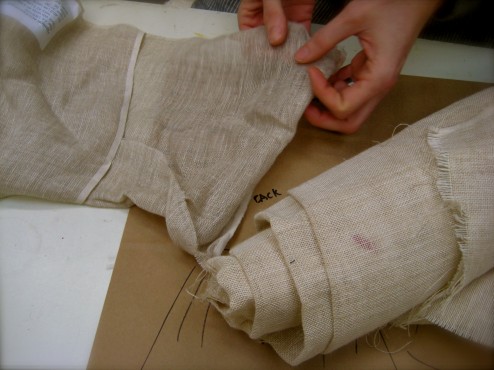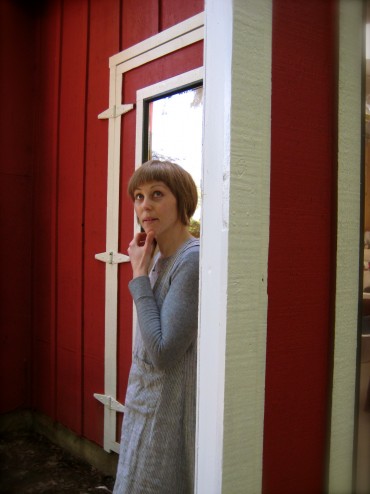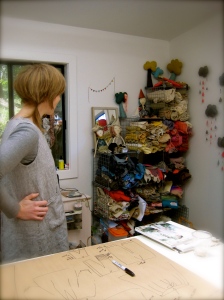Today was spent in Occidental, amongst the redwoods, chickens, goats, and good design everywhere I looked. This is Heidi Iverson, standing outside her renovated red barn studio. She is the knitwear designer who drafted patterns and knit the pieces for our recent book project, and who is currently designing many elements of the of the Fibershed wardrobe. Her designs are imbued with elements of Japanese zen that cross pollinate with french peasantry. Capri bloomers, tunics, and the addition of a splash of vintage Oaxacan woven design elements will culminate in a completely innovative combination. These pieces will allow me the freedom of movement I’ll need on the Mt. Bike, on the trails, while honoring the simplicity of the very raw natural fibers we are working with–many of them handspun, handwoven, and handknit.
Heidi derives inspiration from the rough hewn linen within vintage french grain sacks, and the fragments of Japanese kimonos–all of which provide her a solid creative understanding for how to fully expand and explore the new potentials within our Fibershed. The above sketch is what Heidi calls her ‘chicken scratch,’…… don’t be fooled, behind these simple drawings, is a wake of knowledge and understanding of how to create the most elegant designs with the least cutting and most efficient use of fabric.
The above sketch is what Heidi calls her ‘chicken scratch,’…… don’t be fooled, behind these simple drawings, is a wake of knowledge and understanding of how to create the most elegant designs with the least cutting and most efficient use of fabric.  The summer pieces will primarily be made with the color-grown organic cotton from Sally Fox’s farm, the alpaca is from Julie Anderson, and the merino is sourced from Jean Near in Mendocino. We are working with a light weight brown boucle, which will keep me cool on hot days, and a fingering weight alpaca—that will be dyed in the yellows of coyote brush, and the soft greens of french broom—providing me with an outer layer and perhaps some socks. The merino will be handspun and knit into a base layer to keep me warm during the cool Northern California summer fog mornings—that sometimes turn into fog filled days.
The summer pieces will primarily be made with the color-grown organic cotton from Sally Fox’s farm, the alpaca is from Julie Anderson, and the merino is sourced from Jean Near in Mendocino. We are working with a light weight brown boucle, which will keep me cool on hot days, and a fingering weight alpaca—that will be dyed in the yellows of coyote brush, and the soft greens of french broom—providing me with an outer layer and perhaps some socks. The merino will be handspun and knit into a base layer to keep me warm during the cool Northern California summer fog mornings—that sometimes turn into fog filled days.

The sketching, discussing, and pouring through books inspired clear visions of the form and texture that will emerge from our landscape. To prepare these textures and forms for my body, there is much to do–dye plants must be planted in both my garden, and in other people’s gardens (this year I’ll need lots of growing grounds!). I also look forward to hours on the spinning wheel and the loom.
The art in Heidi’s living room made me smile– thanks to her I am one step closer to the Fibershed wardrobe. I am feeling more confident that I will not be spending my year naked like these little guys.



